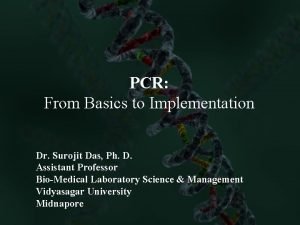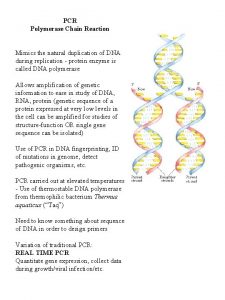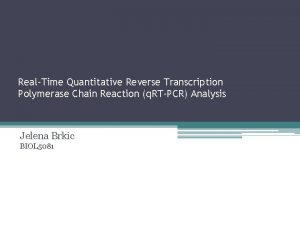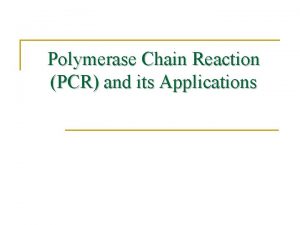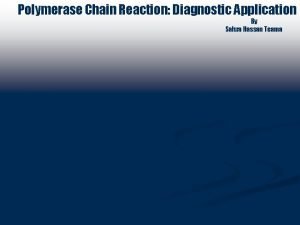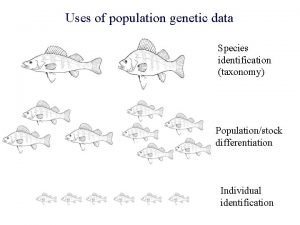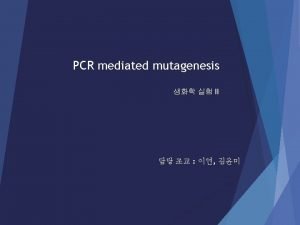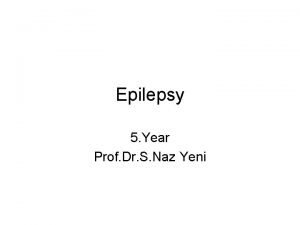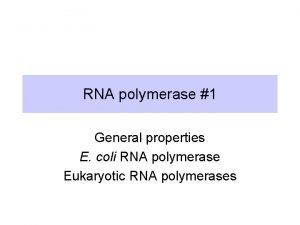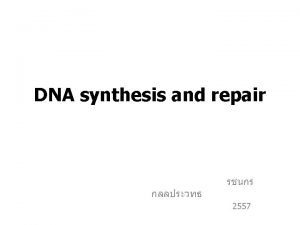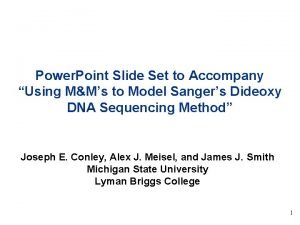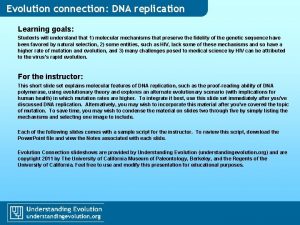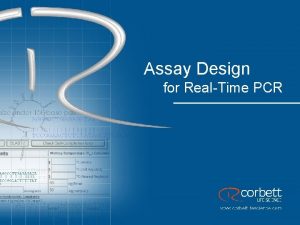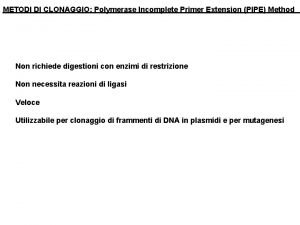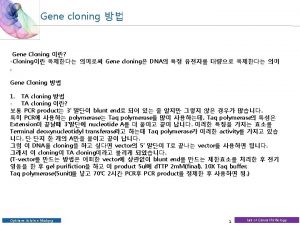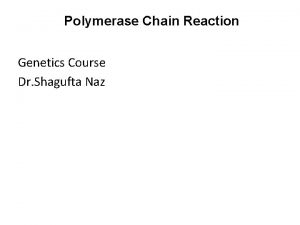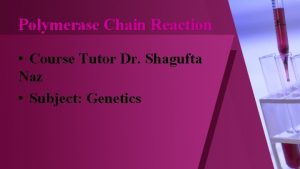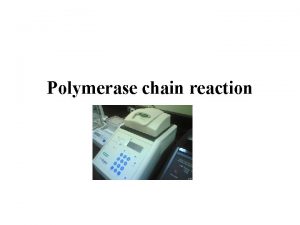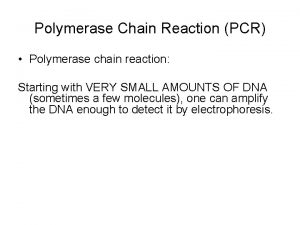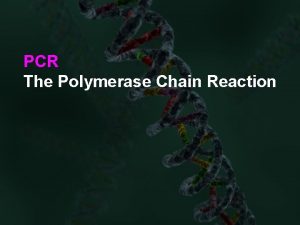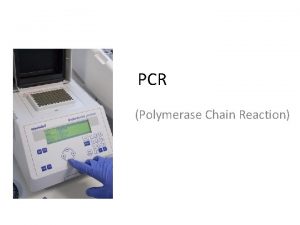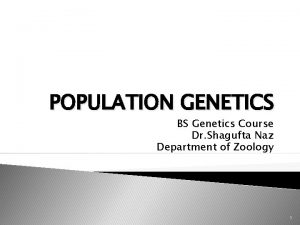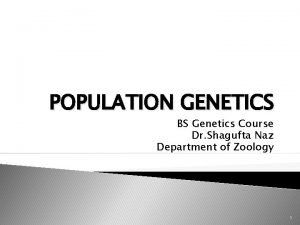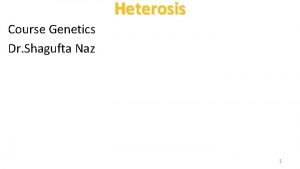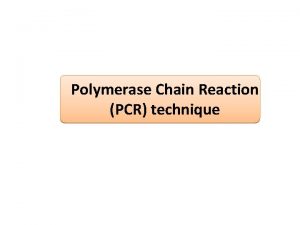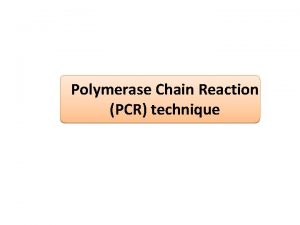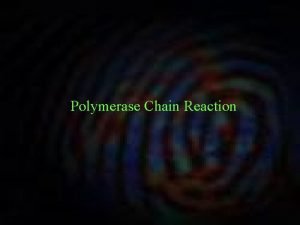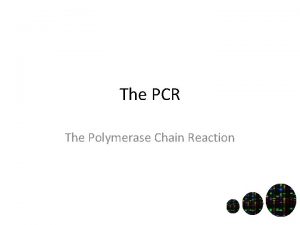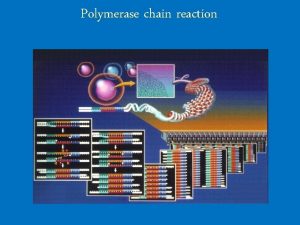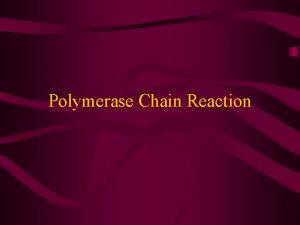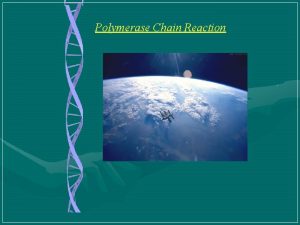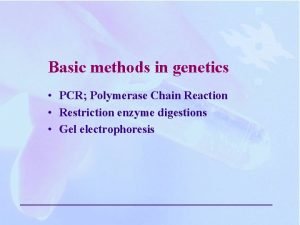Polymerase Chain Reaction Genetics Course Dr Shagufta Naz


























- Slides: 26

Polymerase Chain Reaction Genetics Course Dr. Shagufta Naz

Polymerase Chain Reaction • • History Introduction Components Applications

PCR Polymerase Chain Reaction is a technique used in molecular biology to amplify a single or a copies of a segment of DNA across several magnitude, generating thousands to million copies of a particular DNA sequence

History • Developed in 1983 by Kary Mullis, PCR is now a common techniques used in clinical and research laboratories for a broad variety of applications • In 1993, Mullis was awarded the Nobel Prize in chemistry for his work on PCR

Purpose • To amplify a lot of double-stranded DNA molecules(fragments) with same size and sequence by enzymatic method and cyclic condition.

Components of PCR

The PCR cycle • PCR proceeds in three distinct steps governed by temperature.

Working

Different types of PCR • • • Quantitative PCR Multiplex PCR Nested-semi nested PCR Standard PCR RT-PCR Hot start PCR Asymmetric PCR Touchdown PCR Colony PCR COLD PCR Suicide PCR

Quantitative PCR • Real-Time PCR • PCR with few improvements • Types of q. PCR • Applications Fluorescent based and probe based q. PCR

Multiplex PCR • More than one target sequence can be amplified Types of Multiplex PCR • Single template PCR • Multiple Template PCR Traditional versus Multiplex PCR

Primer design parameters • Primer length • Melting temperature • Specificity • Avoidance of primer-dimer formation Advantages • Internal controls • Efficiency • Indication of template quality • Indication of template quantity Application

Nested-semi nested PCR • • To reduce contamination in products Use of two sets of primers First set is an amplified sequence Second set is complementary to the first set

Nested PCR

Standard PCR • • Simple efficient and sensitive technique Use of one pair of primers Helps in early diagnosis of Brucella Used to determine no of leukocytes DNA/heamo compounds

RT-PCR • Measures RNA expression level • Production of complementary DNA • Use of Reverse transcriptase • Applications RT-PCR

Hot Start PCR • Allows reaction setup at room temperature • Without non-specific amplification and dimer formation Method • Physical separation • DNA polymerase inactivation • d. NTP modifications

Comparison of conventional and Hot start PCR

Asymmetric PCR • Amplifies one strand of target DNA • Thermocycling with limiting amount or leaving out primer

Touchdown PCR • Annealing temperature is decreased in later cycles • In early cycles 3 -5 degree above the standard Tm • Later cycles 3 -5 degree below Tm • Initial higher T leads to greater specificity for primer binding • Lower T permit more efficient amplification at the end of reaction

Normal versus Touchdown PCR

Colony PCR • Bacterial colonies are screened directly • Colonies are separated with sterile pipette tip • Cells are transferred into a PCR mix To release DNA from cells PCR is started either by: • Extended time at 95 degree • Shortened denaturation step at 100 degree • Special chimeric DNA

Colony PCR

COLD-PCR • It is a modified protocol that enriches variant alleles from a mixture of wildtype and mutation-containing DNA. Full COLD and Fast COLD PCR

Inverse PCR

Advantages Simplicity, easier methodology, sensitive, extensively validated standard operating procedure and availability of reagents and equipment.
 Application of pcr
Application of pcr Polymerase chain reaction
Polymerase chain reaction Polymerase chain reaction
Polymerase chain reaction Polymerase chain reaction application
Polymerase chain reaction application Pcr phases
Pcr phases Polymerase chain reaction
Polymerase chain reaction The three steps of polymerase chain reaction
The three steps of polymerase chain reaction Naz kardeşler
Naz kardeşler Naz andrea
Naz andrea Physogenic
Physogenic Naz net time card
Naz net time card Food chain food chain food chain
Food chain food chain food chain Rna polymerase 1 2 3
Rna polymerase 1 2 3 Whats primase
Whats primase Dna prokaryotic
Dna prokaryotic Replication fork
Replication fork Dna replication eukaryotes
Dna replication eukaryotes How many dna polymerase in eukaryotes
How many dna polymerase in eukaryotes Types of dna polymerase in eukaryotes
Types of dna polymerase in eukaryotes Dna polymerase
Dna polymerase Rho independent termination
Rho independent termination Dna polymerase
Dna polymerase Annealing temp pcr
Annealing temp pcr Rna polymerase
Rna polymerase Polilynker
Polilynker Adn polymérase
Adn polymérase Taq polymerase
Taq polymerase
